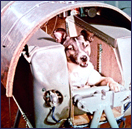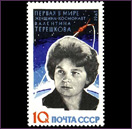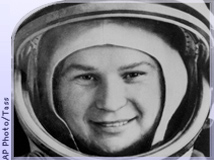
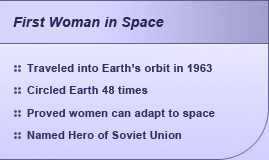
Women can do anything.
—Valentina Tereshkova
On June 16, 1963, Valentina “Seagull” Tereshkova embarked on a trip the world would never forget. That day, the 26-year-old from a humble peasant upbringing left the Earth’s atmosphere to become the first woman in space. Another woman would not follow in her footsteps for almost two decades.
The Parachute Club
One of three children, Tereshkova was born on March 6, 1937, in Maslennikovo, Yaroslavl, in what is now Russia. Her mother worked at a cotton mill, and her father died driving a truck during World War II when she was just two.
Around age 16, Tereshkova started working at a tire factory. In 1955, she joined her mother at the cotton mill and worked there by day while completing correspondence courses at night. For recreation, Tereshkova joined the Yaroslavl Aviation Club in 1959 and took up parachuting. A true enthusiast, she even founded her own community of parachute lovers, the Textile Mill Workers Parachute Club. She also became active in the local Communist Youth League, serving as its secretary.
Inspired by countryman Yuri Gagarin’s historic spaceflight in 1961, Tereshkova applied to be a cosmonaut. At the time, the Soviet space program was seeking women to enter the profession because leader Nikita Khrushchev was eager to launch a woman into space before the United States did; outer space had become an arena for proving scientific superiority.
Tereshkova made the finalist round along with four other female comrades who were vying to become the first woman in space. Though she had no prior flight training, her factory background and parachuting experience made her a desirable candidate.
The program required the women to travel to Star City, a cosmonauts’ educational facility in Russia, where they trained in complete secrecy. Even Tereshkova’s mother was misled, thinking her daughter was joining an elite skydiving team.
Reaching for the Stars
In Star City, the preparation regimen included making over a hundred parachute jumps, which was no problem for the experienced Tereshkova, who excelled at the program’s physical challenges. She easily handled the centrifuge trainer, a machine that was designed to simulate the effects of G-forces in space, despite the centrifuge trainer’s tendency to induce vomiting.
“You thought only you men could stand up to that Devil’s Merry-Go-Round?” she said, referring to the machine.
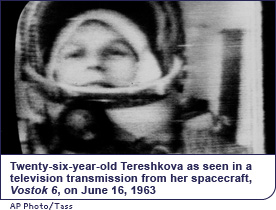 When it came time to select the woman who would make history, Tereshkova, the one with the least flying experience among the finalists, was chosen to pilot the Vostok 6 spacecraft. (Much of the Vostok 6 flight plan was executed by ground control.) She was launched into space by the Soviet Union on June 16, 1963, two days after fellow cosmonaut Valery Bykovksky had gone up in Vostok 5. The Soviets planned to have both in space at the same time in order to study the effects of space travel on a man and a woman. The two cosmonauts traveled in two separate orbits and exchanged greetings.
When it came time to select the woman who would make history, Tereshkova, the one with the least flying experience among the finalists, was chosen to pilot the Vostok 6 spacecraft. (Much of the Vostok 6 flight plan was executed by ground control.) She was launched into space by the Soviet Union on June 16, 1963, two days after fellow cosmonaut Valery Bykovksky had gone up in Vostok 5. The Soviets planned to have both in space at the same time in order to study the effects of space travel on a man and a woman. The two cosmonauts traveled in two separate orbits and exchanged greetings.
Over three days, Tereshkova made 48 orbits around the Earth, as many as the moon makes in four years. She stayed aloft 70 hours and 50 minutes, outdoing the combined flight time of all U.S. astronauts up to that point. “I see the horizon. A light blue, a beautiful band. This is the Earth. How beautiful it is. All goes well,” were the words she spoke to ground control as she orbited the planet.
When Tereshkova returned to Earth, she parachuted down onto the rugged steppes of Kazakstan and received a hero’s welcome. Back in cosmopolitan Moscow, Red Square filled with ebullient women who celebrated her triumphant “first” for females. She had proven that a woman could handle the physical and psychological pressures of space just like men.
Newspapers around the globe headlined Tereshkova’s accomplishment. Khrushchev feted her at the Kremlin, and she subsequently toured Soviet cities and Soviet-bloc nations. She was twice awarded Order of Lenin honors and given the title of Hero of the Soviet Union. In addition, she was named to the World Peace Council, the Soviet Parliament and the Russian Center of International Scientific and Cultural Cooperation.
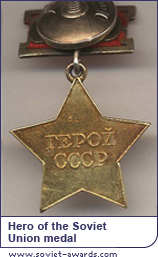
Turbulence Ahead
Soon after the Vostok 6 mission, in November 1963, the first woman in space married Andrian Nikolaev, the USSR’s third man to travel in space. They had first met during her training at Star City. It was rumored that they married for propaganda and scientific purposes—the state allegedly wanted to see how their cosmic travels would affect their offspring. Their daughter, Elena, the first “space baby,” was born the following year and turned out to be healthy. Unfortunately, the relationship between the cosmonauts was not, and their marriage later ended in divorce.
Tereshkova continued her training, this time for a planned 1970 Soviet moon expedition. Priorities shifted, however, and the mission was scrapped. She would never again leave Earth’s atmosphere, nor would any other woman for the next 19 years. Svetlana Savitskaya, also of the Soviet Union, went up in 1982. And on the twentieth anniversary of Tereshkova’s trek, the United States sent its first woman astronaut, Sally Ride.
The Russian space hero continued to make public appearances all over the USSR and the world as a symbol of Soviet feminism. She also held many prominent government positions, including the presidency of the Soviet Women’s Committee and leadership of the Russian Association for International Cooperation, before she retired from the military.
Decades after her spaceflight, Tereshkova was asked how she had felt following her historic voyage. “I was simply overwhelmed,” she said, “with the joy that it was all over and behind—the weightlessness, the closed space of the ship and all sorts of extraordinary situations which, theoretically, might have happened. And when I was back among people, I repeated the words [said] after the flight of Yuri Gagarin: ‘Mankind is no longer chained to its planet.’”
:: woa.tv staff
Read More About Valentina Tereshkova





